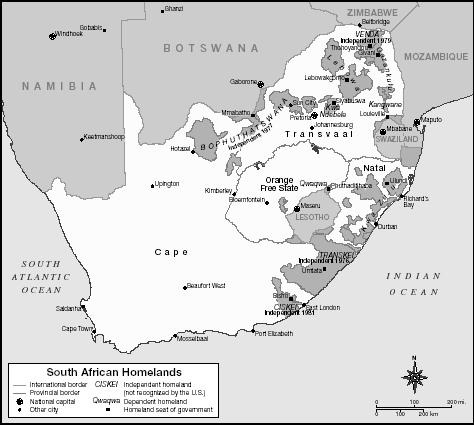During Apartheid, starting from the late 1950s the South African Government attempted to divide South Africa into a number of separate states, called homelands, for Blacks. Under the homeland system, each state was supposed to develop into a separate nation-state for a different ethnic group. According to the Promotion of Bantu Self-Government Act No. 46 of 1959, Black people were classified into ethnic groups for whom a so-called homeland would be established. Approximately thirteen percent of the land which represented fifty percent of South Africa's arable land was reserved and divided into ten Black "homelands" amongst eight ethnic units (Davenport, 1977: p. 268).
The Black Homeland Citizenship Act 26 of 1970 (assent gained 26 March), subsequently renamed the Black States Citizenship Act, 1970 and the National States Citizenship Act, 1970, was a denaturalization law which was instrumental to this effect and required that all South African Blacks become citizens of one of the self-governing territories. The law declared Black people as aliens in urban areas, and could only live there after receiving special permission. It changed the status of Black people living in South Africa so that they were no longer citizens of South Africa, but became citizens of one of the ten autonomous territories. According to the law, "No Black person will eventually qualify [for South African nationality and the right to work or live in South Africa] because they will all be aliens, and as such, will only be able to occupy the houses bequeathed to them by their fathers, in the urban areas, by special permission of the Minister." (Connie Mulder, South African Information and Interior Minister, 1970.)
Four of the states were given independence (Transkei, Ciskei, Bophuthatswana and Venda), although this was never recognised by any other country. Each homeland was supposed to develop into a separate-nation state within which the eight Black ethnic groups were to find and grow their separate national identity, culture and language. The aim was to strip Blacks of their South African citizenship and ensure a demographic majority of White people within South Africa by having all ten Bantustans achieve full independence. In addition, urban townships were established to provide a readily available supply of labour, but had to be far away from white residential areas.
The Homelands were:
Transkei -- Xhosa (given "independence" in 26 October, 1976)
Ciskei -- Xhosa (given "independence" in 4 December, 1981)
Bophuthatswana -- Tswana (given "independence" 6 December 1977)
Venda -- Venda (given "independence" 13 September, 1979)
kwaZulu – Zulu (“Self-government status” in 1 December 1977 )
Lebowa – Pedi (“Self-government status” in 2 October 1972 )
Kangwane – Swazi (“Self-government status” in 8 August, 1984 )
QwaQwa – Sotho (“Self-government status” in 1 November, 1974)
Gazankulu – Tsonga, (“Self-government status” in 1 February, 1973 )
kwaNdebele – Ndebele (“Self-government status” in 1984)
Once a homeland was granted its "independence", its designated citizens had their South African citizenship revoked, to be replaced with citizenship of their homeland.The Bantu Homelands Citizenship Act (National States Citizenship Act) No 26 of 1970 was repealed by the Interim Constitution of the Republic of South Africa Act No 200 of 1993.
 source: www.go.galegroup.com
source: www.go.galegroup.com